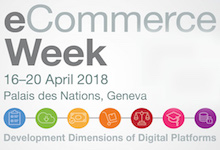What sells in e-commerce: New evidence from Asian LDCs
16 Apr 2018 15:00h - 16:30h
Event report
[Read more session reports from the UNCTAD E-Commerce Week 2018]
This session launched a new publication about the potential of cross-border e-commerce for small and medium sized enterprises (SMEs) in least developed countries (LDCs) by the International Trade Centre (ITC) and AliResearch. The publication uses market data from Alibaba’s business-to-business (B2B) e-commerce platform for five LDCs in Asia: Bangladesh, Cambodia, Lao PDR, Myanmar, and Nepal.
The moderator, Mr Alvaro Cedeno Molinari (Ambassador of Costa Rica to the World Trade Organization (WTO)) introduced the session by outlining some of the great potential benefits, as well as challenges, that LDCs face in the context of e-commerce. He also highlighted the growing role of data, and the difficulties for SMEs in LDCs to access data to improve their performance compared to large companies. He added that e-commerce is not a ‘one-size-fits-all solution’, but that it adjusts to needs and comparative advantages, and these can only be captured by analysing reliable data.
Presenting the report, Ms Marion Jansen (Chief Economist, ITC) explained that the research was conducted in order to understand how SMEs could better target potential markets and clients, and how e-commerce differs from traditional trade. While there were certain limitations to Alibaba’s data – some data was too sensitive to access – it allowed for a new way to analyse the dynamics of the e-commerce market, which has so far been under-researched.
The study found that the participation of SMEs in cross-border e-commerce is increasing, with the number of sellers growing by more than 30% in one year in the countries that were analysed. While there are certain similarities with traditional trade – similar products are traded and the largest export markets continue to be the United States, China, and India – there are also a number of notable differences. E-commerce focuses on processed products that are ready for consumption and allows for a greater diversification of exported products. The products are also generally of higher value, and new destinations have emerged aside from the three largest export markets, especially among Asian countries. The ITC assists LDCs to capture the full benefits of e-commerce by helping them design national export strategies.
Mr Ouyang Cheng (Executive Senior Advisor, AliResearch) provided several examples of the growth in the participation of Chinese SMEs in cross-border e-commerce, which now constitutes 27% of foreign trade. E-commerce allows for new players in international trade, in particular SMEs, new forms of international trade, and a general upgrade of the industrial environment. The participation of SMEs in e-commerce can be promoted through pilot projects and the establishment of an online, comprehensive, single window platform, which can assist SMEs in matters of customs, taxation, foreign exchange, transportation, and financing. Cheng highlighted that successful e-commerce needs to be market driven and supported by public-private sector collaboration.
Dr Mostafa Abid Khan (Minister, Permanent Mission of Bangladesh to the WTO) shared the experience of his country in making the transition to e-trade. Khan explained that Bangladesh has started to adopt a digital strategy in order to provide better government services through the Internet. Through this development, the private sector started to generate ideas for e-commerce. While there are still a lot of bottlenecks to face, such as issues related to payments and consumer trust, e-commerce in Bangladesh is growing quickly, and it currently has an e-commerce association with more than 600 members.
Ms Mina Aryal (Deputy Permanent Representative, Permanent Mission of Nepal to the WTO) explained some of the opportunities and challenges in Nepal for SMEs to benefit from e-commerce. She linked e-commerce developments to the sustainable development goals (SDGs), and in particular SDG target 5b, which aims to enhance information and communications and technologies (ICTs) to promote the empowerment of women. At the same time, Nepal still faces a number of challenges, including those related to logistics, infrastructure, and the lack of an appropriate legal framework.
Mr Kiengkhammanh Khottavong (Counsellor, Permanent Mission of Lao People’s Democratic Republic (PDR) to the WTO) presented some of Lao’s recent regulation, including its e-commerce and ICT laws, and current developments of regulatory frameworks on e-payments and e-signatures. He also explained that there has been significant work in the Association of Southeast Asian Nations (ASEAN) context, such as its agreement on e-commerce, its ICT master plan, and its work on consumer protection. However, considering that Lao has not yet reached the e-commerce growth of some of its neighbours, Khottavong raised the question whether it is too late for Lao to get into the e-commerce market. While a lot of work needs to be done to create an enabling environment for the country’s SMEs to benefit from e-commerce, he noted that the move to e-commerce is ultimately ‘unavoidable’.
Mr Zhang Shige (Senior PR Manager, Huawei Technologies) explained that while e-commerce is an important part of the digital economy, its growth is limited by infrastructure constraints. The improvement of Internet access needs a whole-of-government approach in order to address supply and demand sides issues. In addition, there is a need for training and capacity development to develop local talents, and Shige shared some of Huawei’s projects in this area.
The Q&A that followed raised questioned about the reasons behind the diversification of products enabled by e-commerce, as well as the transformative nature of ICTs for trade. One participant highlighted that while e-commerce could be disruptive, it does not truly address some of the fundamental issues related to trade for LDCs, such as the enhancement of productive capacity.
Molinari closed the session by highlighting some of the examples that had been provided, which underlined the potential of e-commerce for SMEs in LDCs, as it provides important elements for a road-map for e-commerce.
By Barbara Rosen Jacobson
Related topics
Related event

